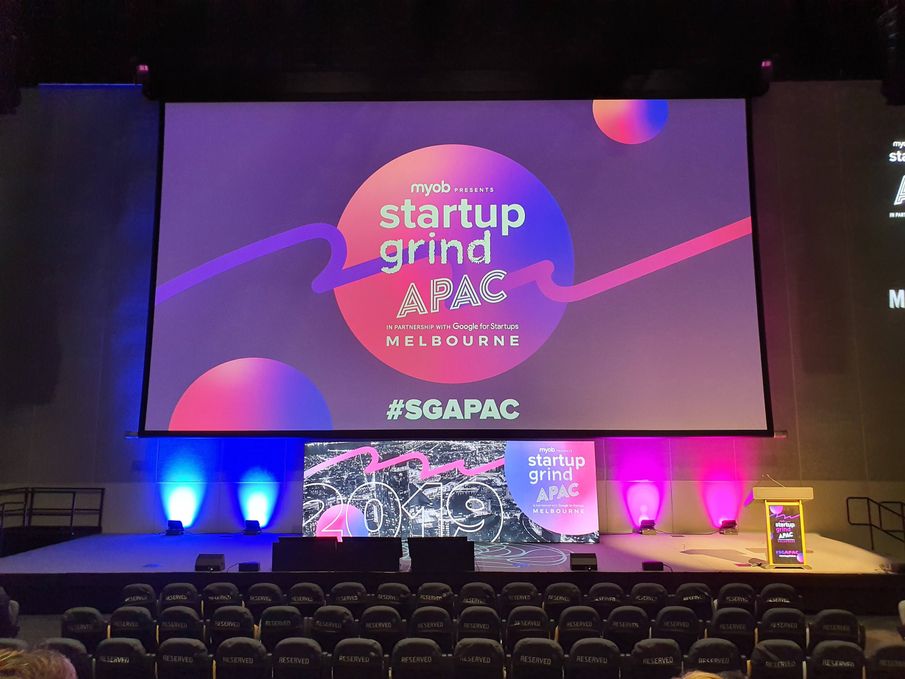Startup Grind APAC was held in Melbourne on the 9th and 10th of December 2019. This article summarises the sessions I attended on the second day of the conference.
# How to Found a Winning Engineering Team - Jonni Gani

I kicked off the morning with a presentation by Jonni Gani from Weploy about the strategies he’s implemented to create the engineering team at WePloy.
The presentation began with a brief history of Jonni’s journey at Weploy. When he started at Weploy, Jonni was the sole engineer. Over the last two and a half years the team has expanded to 12 people, and it has been titled the “product team” as they do more than just write code.
Jonni likened the process of building a team to playing the game Civilization by Take-Two Interactive Software; it’s a matter of searching through the fog to find the “perfect tile” and then building your empire from there.
Some of the challenges in tech recruiting in Australia are caused by competing with the trawlers (organisations like Amazon who do a recruiting drive every 6 or 12 months in Australia and then take all the good engineers to the US), non-natives (such as Square and ZenDesk who have set-up local engineering teams to take advantage of the talent here) and the local giants (such as REA who are an employer of choice for many).
To help negate the impacts these larger organisations have, Weploy started to think of the recruitment process as a product and the candidates and employees as users. They created personas for different employee types and segmented their strategy to work out what was most valuable to employees.
Junior developers were found to be relatively easy to attract as there are few employers that are actively hiring them. Senior developers are also relatively easy to attract with the right offering as many are disillusioned, understand that technologies come and go, are sick of office politics and want to deliver real value to the company and users. Mid-levels are much harder to attract; on an individual basis they have a new found power as they recognise their skills are in demand, they use this to leverage higher wages and are also attracted to the bigger, “cool” brands. With these personas in place Weploy decided to focus on the junior and senior market and to put less effort into the mid-level market. Weploy also used a strategy of hiring people that will trigger viral growth. By hiring people that make others want to join the team it becomes much easier to hire future employees.
As well as recognising the different experience segments, it’s important to recognise that they career landscape is changing. Relative to Jonni’s and my generation, our grandparents would work for a single employer for life; our parents would stay with an employer for a decade or more; our generation would stay with an employer for 2 to 4 years; and the new generation are likely to change employer yearly. Knowing this can impact the strategies and investment in hiring.
It’s also important to recognise the competitive employment landscape. The “big 4” banks can just throw money at developers to get them on-board; start-ups need to focus on other strategies. Weploy demonstrates to potential employees and to current ones that they can make a difference; they honour their mission, and although they can’t afford the salary big banks can offer, they utilise share options to help make up the sort-fall (ensuring they aren’t underpaying staff).
Jonni then switched focus to some of the management and team maintenance aspects of a winning engineering team. He mentioned it is important to focus the right amount of effort on the right parts of a product. As part of this he highlighted the importance of building the right product, and to be less focussed on building the product perfectly. This doesn’t mean throwing quality out the window, but instead put appropriate amounts of effort into the code based on the impact a product or feature will have on the customer. For a core product or feature this will be ensuring best practices are followed and technical excellence is exhibited through the development and maintenance process; for a less utilised feature this may mean delivering a product that has technical debt but does what is required now and in the short term.
To ensure the engineering team can focus on delivering value to customers and enjoy their work it is also important to automate tasks that can be viewed as mundane. Automated testing will allow developers to focus on the product, deliver value to the clients and have confidence in the changes they make. It is also important to ensure that functionality is clear, and that code is understandable. If there are dark corners in a product or feature then developers will seek to avoid that component, and when forced to work on it they will fear the potential impacts of any changes.
Engineers want to know that their work has a positive impact. To achieve this, it is vital to have a feedback loop in place so the developers can see how the product is working, see the benefits of optimisation and know that they aren’t just coding for the sake of coding. This requires an honesty from the business in showing the improvements in income, decrease in expenses or uplift in user happiness.
Most engineers will strive for excellence in all that they do, if this is undirected, they will fall back to technical prowess. With this in mind it is necessary to help developers recognise how to best apply their efforts to deliver value to the user. This can be done through the use of data driven decisions, using data to override our assumptions, and providing a clear direction for the product.
For developers who are used to a B2C environment, the ability to make data driven assessments is relatively easy. A/B Testing in a B2C environment can be implemented and large amounts of data can be gathered relatively quickly. In a B2B environment there are generally fewer visits to each page, this is an impediment to A/B testing as the amount of data is significantly lower, the flip side of this is that B2B clients are usually more willing to provide feedback. Engineering and product teams can take advantage of this by focussing on more qualitative research, but must be careful not to gather too much data as this can increase the lead time to development. Jonni said at WePloy they found the right balance to be talking to 2 or 3 selected users directly and then using the sales and support staff as a proxy for the remaining user base.
No matter how much research is done, or how much engineering excellence is exhibited, there will be times when things go wrong. In these cases, it is important to have adopted a no-blame culture from the top down. When something goes wrong it is rarely the fault of an individual or a single point of failure; when a business recognises this, they can work to resolve systemic issues, improve checks and balances and learn from an otherwise negative experience. To achieve this a culture of honesty, humility and a willingness to accept failure must exist; to help achieve this culture, all staff from the most senior to most junior need to understand that they will not be punished for a negative, and that hiding a failure or a lack of honesty will increase costs and decrease the company’s viability.
As part of the culture, everyone must be striving to be nice and to help others succeed. A common issue within engineering teams is that smart people can often become arrogant, and arrogance doesn’t scale. It’s important to ensure that there are no perceived heroes on the team, these high performers can excel individually, but will have a negative impact o the team.
Remember that a toxic workplace will have a negative impact on team success. Lead by example; encourage speaking up; and make sure individuals are made aware when their attitude or actions could be having a negative impact on the team.
# Partnering: It Takes a Village - Helen Souness
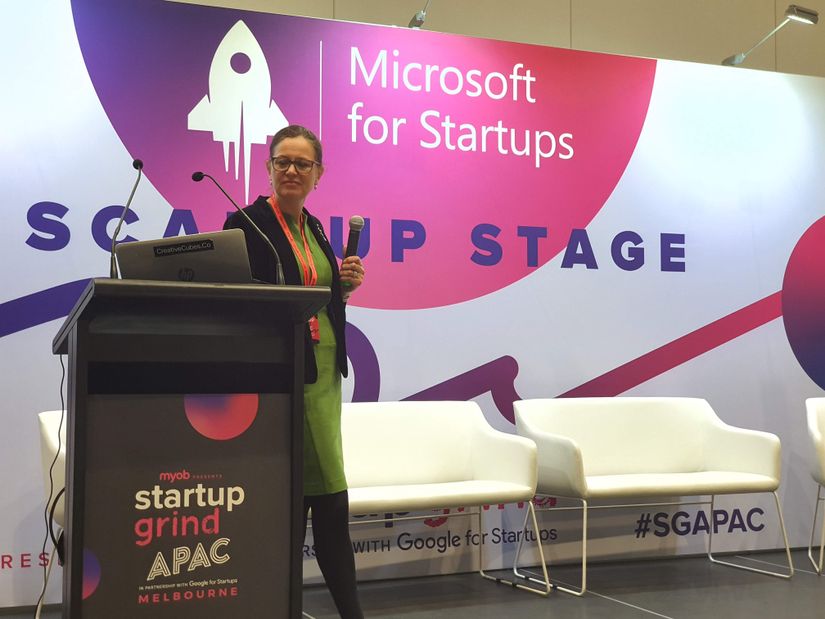
The second presentation I attended for the day was by Helen Souness from RMIT Online.
Helen began with some background about the current skills shortage in Australia; we currently have the largest skills gap in the western world, especially in the tech, digital and health space. To help counter this, RMIT Online has partnered with more than 50 tech-based organisations, all of which are reporting struggles in finding suitably skilled staff.
A common reason the partners have become involved in RMIT Online’s offerings is because they understand what they’re good at. The organisations know what their focus is, what their differentiators are, and what makes them unique as an organisation. They also know what they need.
As with their partners, RMIT Online has also determined the aspects of their business they excel at, and they have asked their partners to provide the skills and expertise for the aspects they cannot fill internally.
Helen mentioned that one of the key aspects of identifying the gaps that can be filled by partners is to then be daring enough to ask for their expertise. In many cases a mutually beneficial arrangement can be found, and people are willing to become involved.
It’s also important for an organisation to be able to react quickly. Go direct to the source, ask the experts and listen to the crowd. As an education provider RMIT Online has found that by listening to the crowd (students, prospective students and employers) they were able to identify emerging technologies that were suitable for courses that would be useful and in demand, but they then found a lack of information available to base a course on. To overcome this, they asked their partners and were able to find subject matter experts who were willing to help create content.
By getting partners involved in the process and the product, not only did they find that partners worked as an amplifier for their brand, but some became town criers, actively promoting and supporting RMIT Online.
# Founder Wellbeing - Omar de Silva
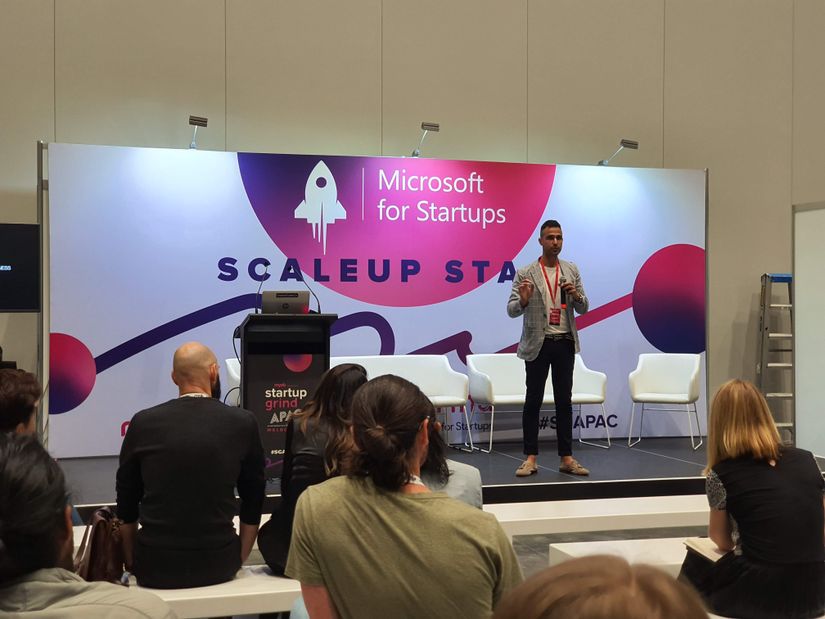
The talk by Omar de Silva from Formen.org about founder wellbeing had a lot of very important content. I am already certain I will not be able to do it justice in this article.
Mental health issues still have a stigma attached to them. This results in people trying to hide common health issues from family and friends and often we don’t have the skills to recognise the signs of a mental disorder or mental illness.
As background, Omar shared his story about how he was always chasing money and status. This left him in debt, and he was advised to declare bankruptcy. Prior to doing this he visited Sri Lanka and saw firsthand the poverty his family had come from. This triggered his determination to pay off his debt instead of declaring bankruptcy and ultimately caused him to further chase money. During this time Omar used work as an escape from stress (something I am guilty of as well).
It is important for everyone to find the right balance and identify their resilience strategies. This is extremely important for founders as they are prone to melding the business and themselves into a singularity.
Omar encountered a stressful period recently; through his previous mental health issues he had learnt the signs of an impending mental disorder and he thought everything would be ok. After a small argument, Omar found he had frozen and was unable to react, this rapidly led to an anxiety or panic attack and he physically collapsed. Despite feeling prepared and educated, this event still took him by surprise.
After sharing such a personal story and making us more aware of the prevalence and impact of mental health issues, Omar shared some insight into his views and some statistics related to mental health.
Throughout the presentation, Omar highlighted several times that we are all fragile, and this is heightened is we have any family history of mental illness. He also told us how important it is to continuously manage mental health, even when this are good, as this can help us to prevent more serious issues.
It’s important to note that coverage of mental health issues in western society has left the term “mental health” as a negative. This isn’t how it should be; we all have mental health and we all face challenges to our mental health. If we don’t manage these challenges, they can grow to become a mental disorder, left unmanaged they can then become a mental illness.
To help highlight the risks to startup founders, Omar shared some statistics about mental health issues and entrepreneurs:
Entrepreneurs are 2x more likely to:
- have depression
- to be hospitalised for psychiatric reasons
- to have suicidal thoughts.
They are also 3 x more likely to undertake substance abuse.
Many investors are looking for a “sleep when I’m dead” attitude. This is simply not sustainable. As entrepreneurs it is important to recognise that success is defined by our self, not by external opinions; a business that is built to achieve our personal view of success is far more sustainable that one that requires us to sacrifice our mental health to meet someone else’s definition of success.
While building a business that meets our definition of success, we also have to actively work to counter the leading causes of mental disorders and illnesses. One of the main causes of these issues is social isolation and loneliness; to counter this, recognise that it is ok to work hard, but it is not okay to work alone; find other entrepreneurs to talk to, utilise coworking spaces, and ensure that you don’t feel like no one understands what you’re going through. Another cause of mental health issues is due to prolonged or severe stress, for example starting a business; with this in mind it is vital to remember that just by starting a business you are setting yourself up for a mental health issue. Other leading causes of mental disorders and illnesses are drugs and alcohol, genetic factors and also trauma (not always acute trauma).
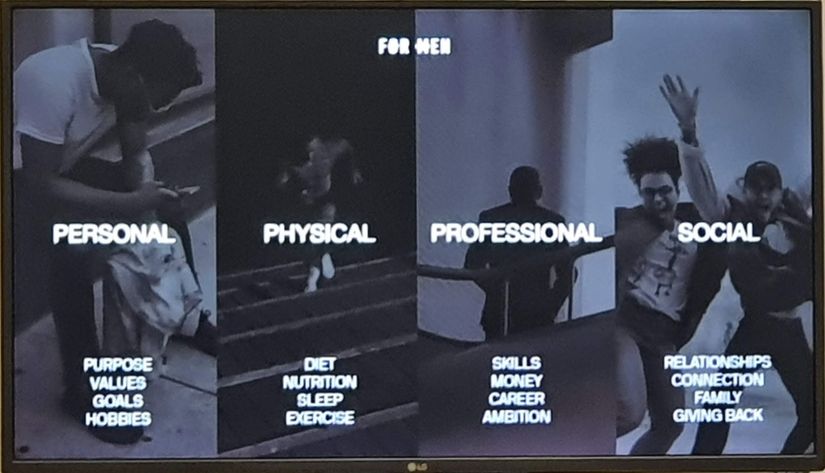
The slide showing the 4 pillars of mental health helps to demonstrate that forgetting about work or your professional life can be detrimental to your wellbeing. When our mental health is suffering, we are often told to take a break, forget about work and relax; for some people (especially entrepreneurs) this can be even more detrimental as we can be so driven by our professional aspects. Instead of neglecting one of these pillars it is important to find the right balance of them at the current time. The balance that is right for you may vary throughout your life, at different times of year and even at different parts of the day or week. Pay attention to what balance works for you and constantly adjust it as needed.
Omar then revisited the importance of finding like-minded people. Many entrepreneurs find that their family and existing friends don’t understand what they are experiencing, this can lead to a feeling of isolation. By actively seeking out other entrepreneurs we can find people who understand the struggles, the celebrations and our drivers; this helps to feel connected and fulfil the social pillar.
As Omar’s presentation drew to a close, he described some of the strategies he uses to maintain his mental health. Rather than write about them in this article, I would encourage you to talk to him about what works for him and to recognise that just because they work for him, it doesn’t mean they will work for you.
To finish his presentation, Omar reminded us that if we are not mentally healthy we will underperform, and as entrepreneurs, we don’t want to be underperforming as this will reduce our chance of success.
# Fireside Chat: Resilience - Alan Downie & Chanie Hyde
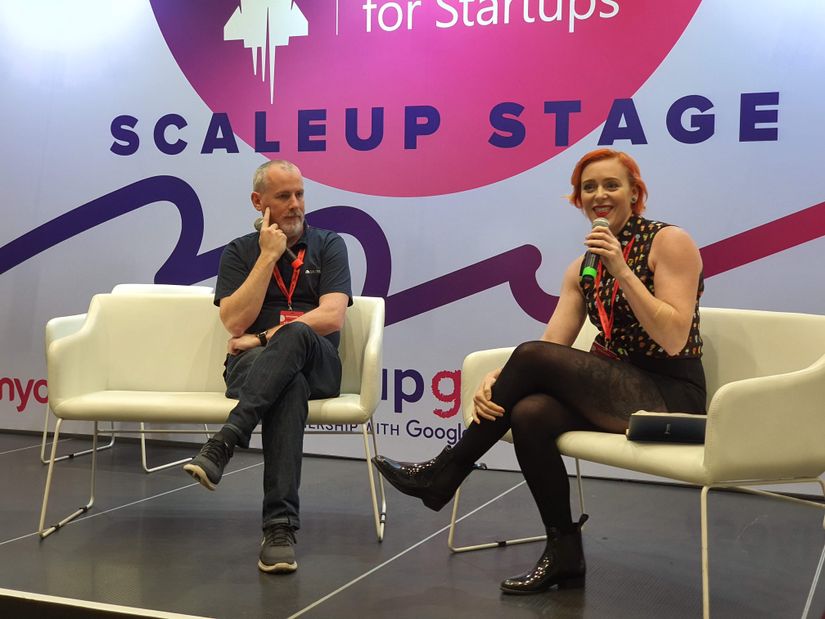
For the fourth session I attended the fireside chat between Alan Downie and Chanie Hyde from BugHerd that focussed on resilience.
As can be observed from this article, the article I wrote about the first day of Startup Grind, the article I will soon write about YOW CTO Summit, and the topics of a number of meetups I’ve attended, the term “resilience” can seem like a buzzword at the moment. We need to remember that it isn’t a buzzword, instead, it is a very important trait/skill that helps us to be successful and survive in our careers.
Due to people having misconceptions, Alan and Chanie began by defining what resilience is not. It is not just continuously trying until you succeed; and it is not fixating on a problem, that would be stubbornness.
Resilience is facing a problem and being able to learn from failure, it is assessing how to improve based on failure, and it is assessing failures to determine if there is value in trying again. This implies that it is also knowing when it is not worth continuing to pursue a course and instead to change direction.
It is important to remember that failure is an almost certainty; even the largest companies will fail at some time, sometimes it is a small failure, sometimes it is the total failure of the organisation. Especially as founders and entrepreneurs we need to recognise when something is failing and be willing to stop investing in it.
Startups are dead by default. A startup begins with no customers and no income. On the first day of a startup it is a failure; one of the challenges for an entrepreneur is to raise the startup from its default failure state and to make it successful. This is not easy, and in many cases is not achievable; be prepared to acknowledge this.
A big part of resilience is to be able to cope with the negative responses that are encountered throughout life. Most startups will regularly be rejected, it could be in seeking investment, it could be in customer acquisition, it could be while hiring employees. Every time we face a “no” we need to learn from it an continue to move ahead. If we stop moving ahead that is when we need to acknowledge that the venture has been unsuccessful.
Having said that people can mistake stubbornness for resilience, there are times when it is necessary to be stubborn. One of the items we should be extremely stubborn about is our belief in our vision. We must know why we are undertaking our journey. Instead of focussing on a solution, we should be focussing on a problem we are trying to solve. This gives us the ability to recognise a failure, learn from it and pivot to find a different solution to the problem.
Alan and Chanie then moved to the topic of drive or ambition. The focus initially was on whether this was a learned or natural. Alan expressed, without any doubt, that it is a learned behaviour. Based on this, Alan and Chanie discussed that in order to succeed with a startup founders need to have had previous failures or struggles. This helps a founder to recognise when it is worth continuing to try and when it is time to stop or pivot. They touched on the need to be able to cope with discomfort, vulnerability and failure and to build resilience to these and be able to learn from all of them. One of the strategies that can be used to help build this resilience is to remember that most of what we do has some risk; if we keep the risk of each decision small then a failure only has a small cost and a success has a small benefit. This strategy works because the failures are not additive, but the successes are, thus the success of the business relies on many small successes and many small failures can be absorbed.
At this point Alan gave a history of his journey starting BugHerd, the problems they encountered in 2015 and the journey to where he is today running Splitrock Studio. This was to help set the scene about finding what is important to him.
As important as it is to know the direction of your business, it’s also important to know your own direction, to find your own North Star. By knowing this guiding star, it enables the fostering of belief in both founder and the project. To help maintain this it is important to be honest with staff, especially when everything is on fire. The honesty will help staff to ride the highs and lows and invest in a venture, as will knowing why each of the staff turn up every day, or what drives them. It also helps the staff to actively help each other if they all know why they’re there and can find what works for each of them individually and as a team.
Another important part of knowing your own North Star is that it will help you to remember to think about yourself; of course it doesn’t matter how much a founder is told not to forget themselves, they will. To help counter this, making sure you don’t risk yourself, your family or your team for money is important. To be successful the primary driver should be to change the world, to improve it. If you do this you shouldn’t need to hustle, leave the hustling for people who are chasing money.
The session finished with a brief Q&A session. The first question was about the pros and cons of joining an accelerator. Alan believe that a accelerator will help to force an outcome, either growth or a crash, but the pace of many accelerators is uncomfortable for many people. The second question was about talking about startups outside startup land; Alan suggested that very few people outside startup land will understand why a founder is going through or why they are doing it. Instead of hoping others in your life will learn about the challenges of a startup, seek support from others in startup land.
# LinkedIn Growth Panel - String Nguyen, Nathaniel Bibby and Lisa Teh, Moderated by Tobi Skovron
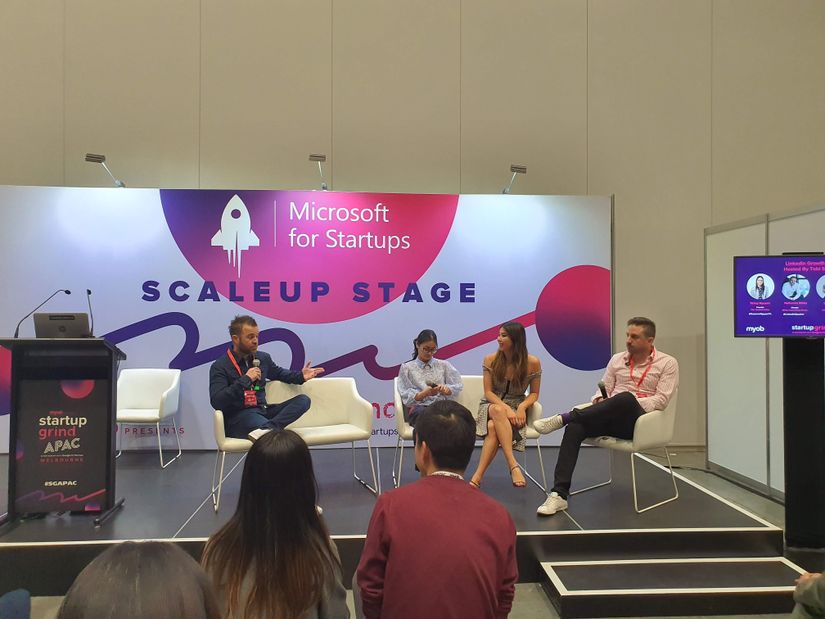
The final session I attended was a panel with String Nguyen from The Trusted Voice, Nathaniel Bibby from LinkedInsider and Lisa Teh from CODI Agency. The panel was moderated by Tobi Skovron from Creative Cubes.
I won’t write too much about this panel as most of the information is easily accessible by following these amazing people.
The first topic was about people going from a connection request and then straight into a hard sell. Although this seemed to get a bit off topic with some of the strategies used to prevent and deal with “thirsty” messages (trolling and publicising these people works well to prevent future attempts), all three panel members agreed that LinkedIn is about relationship building. Before trying to sell someone something a relationship and trust needs to be built and then sales will follow when the time is right for the customer. For those that aren’t willing to invest in a softer sell, messages need to at least be personalised so the recipient knows what problem you will be solving for them.
The second topic the panel covered was about posting frequency. Tobi mentioned he posts 3 times per week, and the panel said this wasn’t enough, but was better than not engaging with the audience at all. To gain the maximum benefit from posting on LinkedIn the key points were to post during transit times for your primary audience (8am, midday or 5pm), post at least daily and be consistent with your posting times. To help facilitate this you need to recognise that it is a big commitment, planning content in advance can help to alleviate some of the pressure and, if you’re using video, pre-recording can help. After posting content it is vital to interact and respond to comments; think of a comment as someone talking to you, if you don’t respond they will just walk away and not come back.
The last topic was about using your network. It was again highlighted that LinkedIn is about engaging with others. Focus on your objectives but remember that without the network of connections and followers you are talking to a void. When you first start posting and becoming active on LinkedIn your posts will not have a significant reach, use this period to hone your delivery and set your focus, get used to engaging with those who interact with you. After around three months you will see your network begin to grow, but don’t get put off in the early stages, just keep going. Don’t stress about your content not being right or containing some mistakes, progress is more important than perfection.
# Conclusion
After a busy couple of days, my energy stores were dry, I decided not to stay for the last few sessions (the startup pitch winner, a fireside chat with Chris Joannou and Gabby Leibovich and a fireside chat with Brendan Yell and Cameron Adams). As much as I would have loved to see these sessions, I knew I had reached my limit.
Overall, the event was amazing, if it hadn’t been for so many amazing sessions across the two days and two stages I might have been able to attend the sessions I missed. To me, the best sign of an amazing conference is for me to be completely depleted in terms of energy, the only way I could have seen all the sessions I wanted was to spread the event of an extra day and to have some less interesting sessions so I could take breaks during the day.
I’m already looking forward to next year!
